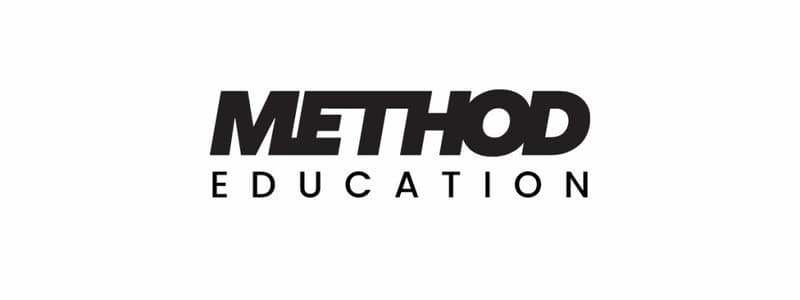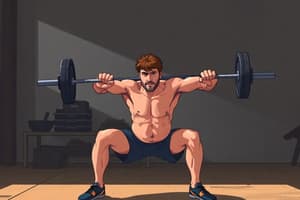Podcast
Questions and Answers
How wide should the stance be for an air squat?
How wide should the stance be for an air squat?
Shoulder-width
Which curve should be maintained while performing an air squat?
Which curve should be maintained while performing an air squat?
Lumbar curve
In a front squat, where should the elbows be positioned?
In a front squat, where should the elbows be positioned?
- Low to the body
- High, parallel to the ground (correct)
- In front of the chest
- Behind the head
What is a common fault in squat execution?
What is a common fault in squat execution?
The hips should initiate movement by moving ___ during a squat.
The hips should initiate movement by moving ___ during a squat.
What position should the bar be over during an overhead squat?
What position should the bar be over during an overhead squat?
What is a primary point of performance in the deadlift?
What is a primary point of performance in the deadlift?
Where should the bar be in relation to the shins during a deadlift?
Where should the bar be in relation to the shins during a deadlift?
What grip should be used during a shoulder press?
What grip should be used during a shoulder press?
In a push press, heels should remain lifted until hips and knees are extended.
In a push press, heels should remain lifted until hips and knees are extended.
What is the stance width for a sumo deadlift high pull?
What is the stance width for a sumo deadlift high pull?
Flashcards
Air Squat - Primary Point
Air Squat - Primary Point
Maintaining a neutral lumbar spine while descending below parallel, with knees in line with toes and weight in heels.
Front Squat - Primary Point
Front Squat - Primary Point
Maintaining a front rack position, keeping the bar close to the frontal plane, with elbows high and shoulders back.
Overhead Squat - Primary Point
Overhead Squat - Primary Point
Maintaining a stable overhead position, keeping the bar close to the frontal plane with shoulders pushing up into the bar, and armpits facing forward.
Shoulder Press - Set-up
Shoulder Press - Set-up
Signup and view all the flashcards
Push Press - Execution
Push Press - Execution
Signup and view all the flashcards
Deadlift - Execution
Deadlift - Execution
Signup and view all the flashcards
Sumo Deadlift High Pull - Execution
Sumo Deadlift High Pull - Execution
Signup and view all the flashcards
Deadlift - Primary Point
Deadlift - Primary Point
Signup and view all the flashcards
Common Squat Fault
Common Squat Fault
Signup and view all the flashcards
Common Press Fault
Common Press Fault
Signup and view all the flashcards
Common Deadlift Fault
Common Deadlift Fault
Signup and view all the flashcards
Study Notes
Air Squat
- Shoulder-width stance
- Full extension at hips and knees
- Hips descend back and down
- Lumbar curve maintained
- Knees in line with toes
- Hips descend lower than knees
- Heels down
Front Squat
- Same set-up as air squat
- Hands just outside the shoulders
- Loose, fingertip grip on the bar
- Elbows high (upper arms parallel to the ground)
Overhead Squat
- Same set-up as air squat
- Wide grip on the bar (for a pass-through)
- Shoulders push up into the bar
- Armpits face forward
Primary Points of Performance
- Lumbar curve maintained
- Weight in heels
- Move to a depth below parallel
- Initiate with the hips moving back
- Knees track in line with toes
Common Faults
- Loss of lumbar curve in flexion
- Weight in, or shifting to, the toes
- Not going low enough
- Initiating with knees so weight is on the toes
- Knees caving inside the feet
- Immature squat
Front Squat Primary Points of Performance
- Same as air squat plus:
- Front rack position maintained
- Bar stays close to the frontal plane
Front Squat Common Faults
- Same as air squat plus:
- Improper rack position (bar not in contact with torso)
- Elbows dropping during the squat (bar moves away from frontal plane)
Overhead Squat Primary Points of Performance
- Same as air squat plus:
- Overhead position maintained
- Bar stays close to the frontal plane
Overhead Squat Common Faults
- Same as air squat plus:
- Inactive overhead position (shoulders inactive, elbows bent)
- Bar moves forward of the frontal plane
Shoulder Press
- Hip-width stance
- Full extension at hips and knees
- Elbows slightly in front of the bar
- Hands just outside the shoulders
- Full grip on the bar
Shoulder Press Execution
- Chin moves back
- Bar moves over the middle of the foot
- Spine neutral and legs extended
- Heels down
- Shoulders push up into the bar
- Complete at full arm extension
Push Press
- Same set-up as shoulder press
Push Press Execution (Dip-Drive-Press)
- Bar rests on torso
- Torso remains vertical as hips and knees flex in the dip
- Hips and legs extend, then arms press
- Heels remain down until the hips and knees extend
- Bar moves over the middle of the foot
- Complete at full hip, knee, and arm extension
Push Press Progression (with PVC)
- Dip and hold
- Dip-drive, slow
- Dip-drive, fast
- Push press
Push Jerk
- Same set-up as shoulder press
Push Jerk Execution (Dip-Drive-Press Under-Stand)
- Bar rests on torso
- Torso remains vertical as hips and knees flex in the dip
- Hips and knees extend rapidly, then arms press to drive under the bar
- Heels stay down until hips and knees extend
- Bar moves over the middle of the foot
- Receive the bar in a partial overhead squat
- Complete at full hip, knee, and arm extension
Deadlift
- Hip-to-shoulder-width stance
- Hands just outside hips with a full grip
- Shoulders over or slightly in front of the bar
- Bar in contact with the shins
- Arms straight
- Eyes on the horizon
Deadlift Execution
- Lumbar curve maintained
- Hips and shoulders rise at the same rate until the bar passes the knees
- Hips then extend
- Bar moves over the middle of the foot
- Heels down
- Complete at full hip and knee extension
Sumo Deadlift High Pull
- Slightly wider than shoulder-width stance; knees in line with toes
- Hands inside the legs with a full grip
- Shoulders over or slightly in front of the bar
- Bar in contact with the shins
- Arms straight
- Eyes on the horizon
Sumo Deadlift High Pull Execution (Deadlift-Shrug-Pull)
- Lumbar curve maintained
- Hips and shoulders rise at the same rate until the bar passes the knee
- Hips then extend rapidly
- Heels down until the hips and legs extend
- Shoulders shrug, then the arms pull
- Elbows move high and outside
- Bar moves over the middle of the foot
- Complete at full hip and knee extension with the bar pulled under the chin
Deadlift Primary Points of Performance
- Lumbar curve maintained
- Weight in heels
- Bar stays close to the frontal plane and body
- Torso angle relatively constant during the initial pull
- Demonstrate active shoulders
Studying That Suits You
Use AI to generate personalized quizzes and flashcards to suit your learning preferences.




